Service & Diagnostics
Call it what you want — the compact performance market, sport compact market, import scene or the tuner market — but there’s no denying the import car performance segment has grown by leaps and bounds over the past decade. According to SEMA’s 2006 Compact Performance Market Report, retail sales for this niche market grew from $4.11 billion in 2004 to $5.04 billion in 2005. This is up from $438 million in 1998.
With such an impressive track record, and continued growth on the horizon, you’re sure to witness this phenomenon first-hand, with new customers coming to your shop for performance upgrades, and existing enthusiast customers, with already modified vehicles, returning for service.
There is also no slowdown in the popularity of the Honda and Acura models when it comes to performance upgrades. These high-quality cars deliver good performance from the factory and have proven to be more than capable of handling both engine and suspension upgrades.
Performance modifications often start with the tires and wheels. Most of my customers do their wheel and tire shopping on the Internet, and it’s hard to argue with their choice. The large retailers have slick websites where you can see how various wheel and tire combos would look on your car. Add in attractive prices and good service, and it’s easy to see the advantages to this option. The downside to mail-order tires is finding someone to mount and balance them. The retailers identified this problem and have developed a network of preferred installers. If you have the proper equipment, get on the list and have them send the enthusiasts right to your door. This gives your shop the opportunity to gain a customer who is looking for high-quality work.
SUSPENSION PACKAGES
The next item to get attention is usually the suspension system to make better use of the tire upgrade and give the car that desired “low and mean” look. Over the years, there’s been quite a bit of development within the suspension industry. Gone are the days when tuners cut the stock spring to lower and stiffen their car. Now they can either install a shorter, stiffer spring, or use the more popular “coil-over” setup. What makes this system different is adjustability. The kit includes a threaded sleeve with an adjustable collar that acts as a lower spring seat. With a small-diameter, shorter spring, along with a large selection of spring rates, the owner has the option of setting his ride height where he wants it. Like a lot of things that find their way to the street market, coil-over kits were first used on race cars.
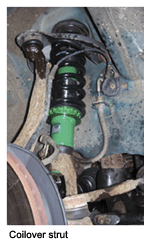 For the race teams, the adjustability allows them to enhance handling by adjusting the static weight at each wheel. For the street enthusiast, the advantage is the opportunity to adjust the ride height for varying road conditions or vehicle use. It’s not uncommon for the serious tuner to lower the car when it’s used for a competition event such as an auto cross, open track day or even a car show, then raise the ride height for everyday street use. Of course, the alignment has to be adjusted as the height is changed, but that’s not a big problem for the serious competitor.
For the race teams, the adjustability allows them to enhance handling by adjusting the static weight at each wheel. For the street enthusiast, the advantage is the opportunity to adjust the ride height for varying road conditions or vehicle use. It’s not uncommon for the serious tuner to lower the car when it’s used for a competition event such as an auto cross, open track day or even a car show, then raise the ride height for everyday street use. Of course, the alignment has to be adjusted as the height is changed, but that’s not a big problem for the serious competitor.
Installing shorter springs or a coil-over kit may present a few problems. Upgraded struts should be installed with the springs as part of the suspension package. Most import shock manufacturers offer units with valving that will dampen the stiffer springs while improving the car’s handling. Many companies offer adjustable struts that are popular with serious drivers. To finish off the suspension, a pair of large-diameter sway bars will ensure that the car corners with little body roll. By using upgraded sway bars, a softer spring can be used for better ride quality.
When installing the suspension parts, there are some pitfalls to avoid. The most common problem is trying to run the car too low. There is a point where you will run out of suspension travel. Usually the limiting factor will be strut travel. Even the best-handling car will behave poorly if the top of the strut hits the bump stop in the middle of a corner. Some kits recommend cutting down the stops to increase travel, but be careful that you don’t make them so short that the strut shaft and valving contact the bottom of the strut housing in a bump situation. It won’t take too many hits to damage the valving located at the base of the shaft.
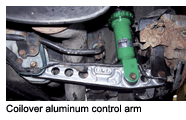 As you’re installing the parts or diagnosing a lowered car that doesn’t handle well, be aware of anything that may cause the suspension to bind. Put a jack under the control arm to confirm that you have the necessary clearance for the suspension to operate. This is a good time to check the clearance between the top of the strut housing and the bump stop. Take a good look at the ball joints; be sure there is enough travel left in the joints to permit movement without binding. All of these problems can be avoided by retaining a reasonable ride height.
As you’re installing the parts or diagnosing a lowered car that doesn’t handle well, be aware of anything that may cause the suspension to bind. Put a jack under the control arm to confirm that you have the necessary clearance for the suspension to operate. This is a good time to check the clearance between the top of the strut housing and the bump stop. Take a good look at the ball joints; be sure there is enough travel left in the joints to permit movement without binding. All of these problems can be avoided by retaining a reasonable ride height.
You can’t lower a car without changing the suspension geometry. As the car is lowered, the inner pivots of the control arm move down with the chassis, while the ball joints remain in the stock position. This change of geometry results in excessive negative camber and poor tire wear. Hondas do not have adjustable camber, but there are adjustable aftermarket camber kits available to address this problem.
Up front there are replacement upper control arms that are equipped with a bolt-in ball joint. The holes for the joint are slotted, allowing the alignment tech to move the ball joint outward to compensate for the negative camber.
At the rear, depending on the model, there are upper control arms that can be adjusted like a tie rod. Simply turn the sleeve to adjust the length of the arm. On other models, the kits have overlength high-strength bolts that allow the tech to place shims between the stock upper arm and the mounting points on the chassis. This moves the upper pivot outward to compensate for the negative camber.
When you’re doing an alignment on a modified car, set the camber to the far side of the negative camber spec. A little negative camber will ensure that the tire has a good contact patch on the road going around corners. For shops equipped to do wheel alignments, performance work can be a good way to keep the alignment machine in use. It may take a little longer to do a good alignment on a modified car, but these customers are willing to pay for quality.
BRAKE UPGRADES
Now that the car handles better, the next step is to upgrade the brakes. Again the aftermarket has stepped up and there are many brake upgrades available for all the popular Honda and Acura models. 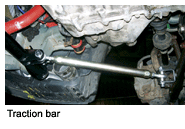 Upgrading to oversized wheels creates room to install large rotors, while at the same time making the brake components more visible, motivating changes for aesthetic as well as performance enhancements. Cross-drilled or slotted rotors, upgraded brake hoses and high-performance pads seem to be the most common upgrades; with the more serious folks choosing to use oversized rotors and multi-piston calipers. The modified rotors are designed to enhance braking performance by dissipating heat better than standard vented rotors.
Upgrading to oversized wheels creates room to install large rotors, while at the same time making the brake components more visible, motivating changes for aesthetic as well as performance enhancements. Cross-drilled or slotted rotors, upgraded brake hoses and high-performance pads seem to be the most common upgrades; with the more serious folks choosing to use oversized rotors and multi-piston calipers. The modified rotors are designed to enhance braking performance by dissipating heat better than standard vented rotors.
The standard rubber brake hoses get replaced with stainless steel-covered lines, resulting in a solid pedal, while adding to the overall appearance of the brake package.
The compounds used for high-performance brake pads are formulated to withstand the higher temperatures generated by spirited driving. The downside to using these pads is that they aren’t very effective when cold, and pedal pressure can be very high. We try to steer the customer toward a less-aggressive metallic street pad.
Unless the car is going to be used at track events, street pads will give the best performance. Also, don’t forget to change the brake fluid. Fresh, high-quality fluid will go a long way toward preventing brake fade caused by boiling.
EXHAUSTING THE POSSIBILITIES
No modified car would be considered complete without the sound to go with it, so exhaust upgrades are very popular modifications on Hondas. The most common upgrade is a cat-back system consisting of large diameter pipes and a free-flow muffler with an oversized exhaust tip. The larger diameter will require that extra care be taken in hanging the system to prevent rattles and vibrations.
Performance enthusiasts also will be considering a set of exhaust headers. Headers replace the stock exhaust manifold and downpipe with four steel tube exhaust pipes, ending at a large diameter collector. A well-designed set of headers will send the exhaust out of the cylinder with enough velocity to create low pressure in the cylinder. This allows the fresh air/fuel mixture to begin filling the cylinder during the valve overlap period. Some manufacturers make the headers in a two-piece design for easy installation. Most headers include O2 sensor bungs and the parts required to connect the collector to the converter in an effort to maintain the legality of the vehicle.
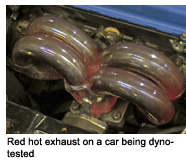 On the other side of the engine is the intake system. Like the exhaust, a cold air intake is a must. The cold air system replaces the stock air cleaner box and the associated tubing with an anodized steel or aluminum tube, which connects the throttle body to a cone-shaped air filter that flows more air than the stock filter. The “cold air” name comes from the fact that the filter is mounted outside of the engine compartment, where dense, cool air is available. Using the hole that feeds the air to the stock box, the tube terminates in the area behind the bumper where the air filter is clamped to the tube. To prevent water damage to the engine, the better systems have a small filter in the tube under the hood that allows air to be drawn into the tube, preventing water and snow from being drawn into the engine.
On the other side of the engine is the intake system. Like the exhaust, a cold air intake is a must. The cold air system replaces the stock air cleaner box and the associated tubing with an anodized steel or aluminum tube, which connects the throttle body to a cone-shaped air filter that flows more air than the stock filter. The “cold air” name comes from the fact that the filter is mounted outside of the engine compartment, where dense, cool air is available. Using the hole that feeds the air to the stock box, the tube terminates in the area behind the bumper where the air filter is clamped to the tube. To prevent water damage to the engine, the better systems have a small filter in the tube under the hood that allows air to be drawn into the tube, preventing water and snow from being drawn into the engine.
Like exhaust, most of these systems are purchased for the way they look and sound. The quality of these components and how they fit will vary according to the manufacturer. The more universal systems will make contact with the hood and rattle, so the large diameter pipe requires care in routing.
ENGINE MODS
For serious enthusiasts, there are many options available to upgrade the engine performance of their Hondas. The most popular of these are engine swaps that involve fitting a larger or higher-performance level engine into a chassis that wasn’t equipped that way from the factory. With some combinations, this can be a bolt-in swap, while others will require motor mount kits. The ECU and its wiring harness will have to be upgraded along with the engine. Many suppliers are providing ECUs and harnesses with the engines to facilitate the installation.
Turbocharging is becoming the method of choice for folks looking for large power gains in a hurry. With kits that are designed for use with stock engines, turbocharging provides large performance increases in a hurry, giving instant gratification to a generation that’s looking for just that.
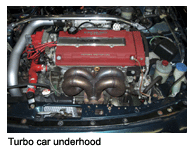 These upgrades are very effective at increasing power, but also create stress on engine components that were not designed for such loads. Good power and reliability are obtainable with reasonable boost pressures. Although these jobs aren’t difficult, only shops that are familiar with internal engine repair should handle them.
These upgrades are very effective at increasing power, but also create stress on engine components that were not designed for such loads. Good power and reliability are obtainable with reasonable boost pressures. Although these jobs aren’t difficult, only shops that are familiar with internal engine repair should handle them.
We are seeing more guys willing to dig into the engine in the search of greater performance, better reliability or both. It’s not unusual for a camshaft to be replaced, compression adjusted or heavy-duty internal parts installed to enhance the power output. Honda has hit the mark with the VTEC variable cam timing system.
In the old days, if a cam were to be replaced, we had the choice of a low-rpm torque grind or a grind that would increase power at the top end of the rpm range. With the advent of variable cam timing and Honda’s VTEC system, in particular, it’s a rare case of being able to have your cake and eat it, too. Now the cam grinders can give us a profile that works very well at the bottom, and we can have a top-end grind when the VTEC system switches modes. With the advent of VTEC, we have even more control over the cam timing; delivering even more performance, for both normally aspirated and cars with boosted intake.
As we increase the engine’s ability to ingest air, we need to better control the fuel. This is an area where we continue to see exciting innovation. On the hardware side of things, we have high-flow injectors available, as well as oversized injector rails to feed them. Adjustable fuel pressure regulators are used to increase the available pressure. And, if the stock pump isn’t up to the task, there are high-flow aftermarket pumps available.
When it comes to injector control there are many options available, such as programmable ECUs or add-on interface boxes that modify the input signals to the stock control unit, giving the user control of the output signals. By using these devices, it’s possible to dial in the control system to match any upgrades that are made to the engine.
The latest developments include full replacement ECUs that are plug-and-play into the stock harness that provide the same adjustability once reserved for high-end units that required replacement harnesses and sensors. These stand-alone systems provide higher resolution to better fine-tune the system using a laptop computer. ECU tuning is not necessarily intuitive and has become a profitable part of the business for shops with the training and equipment to handle it.
On cars equipped with VTEC, these same devices allow the driver to control when the VTEC operates. The other item that has become almost standard equipment is the air/fuel ratio gauge. Using the signal from the O2 sensor, this gauge lets the driver know if the fuel mixture is correct. Again, as the OEMs move forward so does the performance aftermarket. The latest systems use wideband AFR sensors that provide even more accurate information to the driver, helping him better tune his ECU. One of the latest developments is the capability of aftermarket ECUs to write their own maps or self-tune based on the information provided by the O2 sensor. Much like an unmodified car going through its self-learning process, this opens up the technology to a much wider audience.
Having an in-house chassis dyno, and doing quite a bit of testing on Hondas that have been modified, we’ve found that if the engine is mostly stock and modified with only a cold air intake, exhaust headers and a free-flow muffler, the stock Honda fuel system is all that’s needed for good performance.
If the engine has extensive modifications, much can be gained by tweaking the fuel curve. As professional techs, there are also legal issues we have to consider. We have to be careful with what we install so as not to run afoul of emissions laws. For the most part, many high-quality exhaust headers and intake systems have the approval of the California Air Resources Board.
Is performance work right for your shop? Only you can decide. From a shop owner’s point-of-view, the most important element of being successful in the performance field is to have a tech who is interested in doing this type of work. An experienced tech can perform any of the work we have talked about, and many enjoy the diversion that performance work brings. On the other hand, if the tech isn’t willing to spend the time to do a high-quality job, the chance of attracting more business is slim.
If your shop builds a reputation as the place to go for this kind of work, you can expect plenty of it. Performance work is a good way to keep the bays busy, while attracting customers who truly love their cars. Caps Coilover strut Coilover aluminum control arm Traction bar Red hot exhaust on a car being dyno-tested Turbo car underhood






